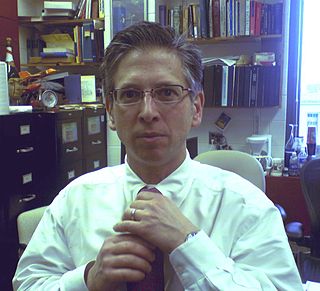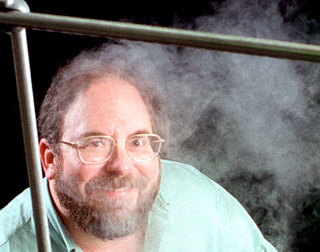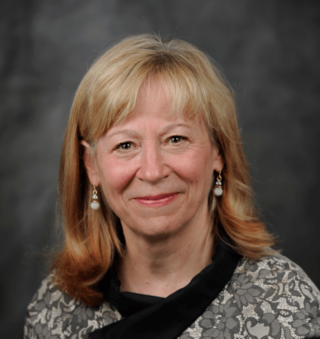
Self-assembled monolayers (SAM) of organic molecules are molecular assemblies formed spontaneously on surfaces by adsorption and are organized into more or less large ordered domains. In some cases molecules that form the monolayer do not interact strongly with the substrate. This is the case for instance of the two-dimensional supramolecular networks of e.g. perylenetetracarboxylic dianhydride (PTCDA) on gold or of e.g. porphyrins on highly oriented pyrolitic graphite (HOPG). In other cases the molecules possess a head group that has a strong affinity to the substrate and anchors the molecule to it. Such a SAM consisting of a head group, tail and functional end group is depicted in Figure 1. Common head groups include thiols, silanes, phosphonates, etc.

Paul S. Weiss is a leading American nanoscientist at the University of California, Los Angeles. He holds numerous positions, including UC Presidential Chair, Distinguished Professor of Chemistry and Biochemistry, Bioengineering, and of Materials Science and Engineering, founder and editor-in-chief of ACS Nano, and founding partner and board member at Kronos Fusion Energy since 2022. From 2019–2014, he held the Fred Kavli Chair in NanoSystems Sciences and was the director of the California NanoSystems Institute. Weiss has co-authored over 400 research publications and holds over 40 US and international patents.

George McClelland Whitesides is an American chemist and professor of chemistry at Harvard University. He is best known for his work in the areas of nuclear magnetic resonance spectroscopy, organometallic chemistry, molecular self-assembly, soft lithography, microfabrication, microfluidics, and nanotechnology. A prolific author and patent holder who has received many awards, he received the highest Hirsch index rating of all living chemists in 2011.
Tobin Jay Marks is an inorganic chemistry Professor, the Vladimir N. Ipatieff Professor of Catalytic Chemistry, Professor of Material Science and Engineering, Professor of Chemical and Biological Engineering, and Professor of Applied Physics at Northwestern University in Evanston, Illinois. Among the themes of his research are synthetic organo-f-element and early-transition metal organometallic chemistry, polymer chemistry, materials chemistry, homogeneous and heterogeneous catalysis, molecule-based photonic materials, superconductivity, metal-organic chemical vapor deposition, and biological aspects of transition metal chemistry.
Harry George Drickamer, born Harold George Weidenthal, was a pioneer experimentalist in high-pressure studies of condensed matter. His work generally concerned understanding the electronic properties of matter.
Robert Graham Cooks is the Henry Bohn Hass Distinguished Professor of Chemistry in the Aston Laboratories for Mass Spectrometry at Purdue University. He is an ISI Highly Cited Chemist, with over 1,000 publications and an H-index of 144.

Peter John Stang is an American chemist and Distinguished Professor of chemistry at the University of Utah. He was the editor-in-chief of the Journal of the American Chemical Society from 2002 to 2020.

Kenneth S. Suslick is the Marvin T. Schmidt Professor of Chemistry Emeritus at the University of Illinois at Urbana–Champaign. His area of focus is on the chemical and physical effects of ultrasound, sonochemistry, and sonoluminescence. In addition, he has worked in the fields of artificial and machine olfaction, electronic nose technology, chemical sensor arrays, and the use of colorimetric sensor arrays as an optoelectronic nose.
M. Christina White is a professor of chemistry at the University of Illinois at Urbana-Champaign. Her research in the field of organometallic catalysis focuses on developing highly selective carbon–hydrogen bond activation methods to streamline the process of complex molecule synthesis.
Jeffrey Scott Moore is the Murchison-Mallory Professor of Chemistry and a Professor of Materials Science & Engineering at the University of Illinois at Urbana–Champaign. He has received awards for both teaching and research, and as of 2014, was named a Howard Hughes Medical Institute Professor. In 2017, he was named director of the Beckman Institute for Advanced Science and Technology at the University of Illinois, after serving as Interim Director for one year.

Geraldine Lee Richmond is an American chemist and physical chemist who is serving as the Under Secretary of Energy for Science in the US Department of Energy. Richmond was confirmed to her DOE role by the United States Senate on November 5, 2021. Richmond is the Presidential Chair in Science and professor of chemistry at the University of Oregon (UO). She conducts fundamental research to understand the chemistry and physics of complex surfaces and interfaces. These understandings are most relevant to energy production, atmospheric chemistry and remediation of the environment. Throughout her career she has worked to increase the number and success of women scientists in the U.S. and in many developing countries in Africa, Asia and South America. Richmond has served as president of the American Association for the Advancement of Science, and she received the 2013 National Medal of Science.
CatherineJ. Murphy is an American chemist and materials scientist, and is the Larry Faulkner Professor of Chemistry at the University of Illinois at Urbana-Champaign (UIUC). The first woman to serve as the head of the department of chemistry at UIUC, Murphy is known for her work on nanomaterials, specifically the seed-mediated synthesis of gold nanorods of controlled aspect ratio. She is a member of the American Association for the Advancement of Science, National Academy of Sciences, and the American Academy of Arts and Sciences in 2019.
Theodore Lawrence Brown is an American scientist known for research, teaching, and writing in the field of physical inorganic chemistry, a university administrator, and a philosopher of science. In addition to his research publications, Brown has written textbooks on general chemistry and science communication which have been published in multiple languages and used in multiple countries. He is a professor emeritus at the University of Illinois at Urbana-Champaign, where he has also held the administrative positions of vice chancellor for research and dean of the graduate college (1980–1986). He is the founding director emeritus of the Beckman Institute for Advanced Science and Technology.
Cathleen M. Crudden is a Canadian chemist. She is a Canada Research Chair in Metal Organic Chemistry at Queen's University at Kingston. In February 2021, she took up the role of Editor-in-chief at ACS Catalysis.
Prashant Jain is an Indian-born American scientist and a professor of chemistry at the University of Illinois Urbana–Champaign where his research laboratory studies the interaction of light with matter, designs nanoparticle catalysts, and develops methods for mimicking plant photosynthesis. He is a Fellow of the American Association for the Advancement of Science and the Royal Society of Chemistry, a TR35 inventor, a Sloan Fellow, a PECASE recipient, a Royal Society of Chemistry Beilby medalist, and a top-cited researcher in chemical sciences.
Milan Mrksich is an American chemist. He is the Henry Wade Rogers Professor at Northwestern University with appointments in chemistry, biomedical engineering and cell & developmental biology. He also served as both the founding director of the Center for Synthetic Biology and as an associate director of the Robert H. Lurie Comprehensive Cancer Center at Northwestern. Mrksich also served as the Vice President for Research of Northwestern University.
Sankaran "Thai" Thayumanavan is an Indian-American chemist, who is currently a Distinguished Professor of Chemistry at the University of Massachusetts Amherst. He is known for his work in polymer chemistry. He is a Fellow of the American Association for the Advancement of Science (AAAS).
Emily A. Weiss is the Mark and Nancy Ratner Professor of Chemistry and director of the Photo-Sciences Research Center at Northwestern University. Her research considers the optical and electronic properties of nanostructures, including hybrid organic–inorganic quantum dots. She was a two-time finalist in the Blavatnik Awards for Young Scientists.
Christopher William Bielawski is a distinguished professor at Ulsan National Institute of Science and Technology and group leader of the Synthesis Group in the Center for Multidimensional Carbon Materials. His research in synthesis and polymer chemistry has resulted in more than 290 publications and multiple patents.
Christy F. Landes is an American physical chemist who is the Jerry A. Walker Endowed Chair in chemistry at the University of Illinois Urbana-Champaign. She previously was the Kenneth S. Pitzer-Schlumberger Chair at Rice University. She seeks to understand the structure-function relationships in biological processes and materials. She was appointed a National Academy of Sciences Kavli Fellow in 2019.






